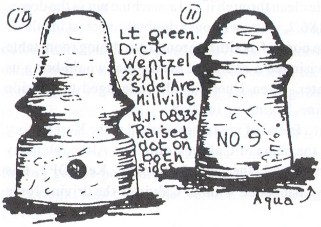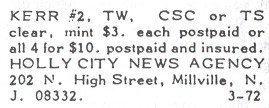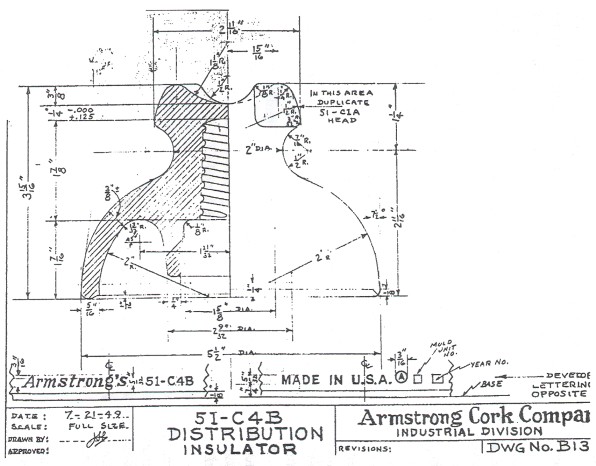The Rarest Beehive in the World
by Richard Wentzel
Reprinted from "Crown Jewels of the Wire", July 1994, page 5
25 Years of Collecting
Searching through the memories of my childhood, I can't recall a single
family vacation that didn't eventually end up alongside a set of railroad
tracks. It was, I suppose, only natural that we gravitate toward the "high
iron", given my family's railroading heritage. My great-grandfather was a
signal tower operator in my hometown of Millville, New Jersey, and my father
worked for many years as a railway postal clerk, serving in New Jersey and
eastern Pennsylvania.
So, on the first day of our annual summer vacation, the
year 1967, it came as no surprise that our destination was an isolated railroad
junction in rural southeastern New York state, a place by the name of Campbell
Hall. Here, where the New York, Ontario & Western once crossed the Erie,
would be the place where I received my initiation into the world of insulator
collecting.
As our station wagon rounded a bend in the road and pulled parallel
with the Erie-Lackawanna mainline, the excitement level of two little boys in
the back seat began to rise. My brother and I bounced out of the car almost
before it stopped. Dad looked at his "magic book" (employee timetable)
and pronounced that it would be a while before a train made its appearance here.
My mother dutifully began to set out the trappings of our "cinder
picnic". Now, it was time to explore!
No sooner had we crossed the tracks
and scrambled down an embankment when our great discovery was made. Lying on the
ground in unfamiliar repose was the very familiar form of a telegraph pole.
Never previously having had the opportunity to study one at such close range, I
had likewise never given any thought to the curious glass objects mounted atop,
now made so accessible. "What are these things, Dad?" I asked.
"Insulators," came the reply, "see if you can find something to
put them in."
I managed to locate a battered wooden bucket once used to
hold railroad spikes, and we proceeded to liberate as many specimens as would
fit into that container, plus a few more for our pockets. Most of the insulators we found that day were ice blue Whitall Tatum No.1' s, but the
small variety of shapes, colors and names were more than enough to capture my
youthful imagination and launch me into starting a collection.
In those early
days, it was quite easy to find new additions for my display shelf. Virtually
every trip along a railroad right-of-way yielded something different. We would
kick around the base of each pole, and in the surrounding underbrush where a
lineman might conceivably have thrown an outdated insulator. Success came so
often and was so sweet!
I was nothing short of full-tilt gung-ho about our
collecting expeditions. I'm reminded of an outing along the Reading Railroad
just outside of its namesake city . We were kicking up CD 147 spiral grooves
left and right. These were brand new pieces for us at the time. We hadn't worked
more than a dozen or so poles before we came to a low trestle. Midway across the
span, my father and I both noticed the skunk at the same time. I really wanted
to continue, and tried my best to convince my dad that the skunk was dead, even
to the point of suggesting that we throw stone at it to see if it moved! My
father's wisdom prevailed, however, and I groused all the way home.
As
satisfying as our ground-based efforts were, it wasn't long before our attention
focused skyward at the insulators still on the poles. My father elected not to
climb poles, so we developed a device designed to spin an unwired insulator off
its pin. This simple system was composed of sections of wood handrail, one of
which sported a roughed-up rubber insulator permanently attached to its end. We
fitted the sections together in metal sleeves, assembling a pole appropriate for
the height of the crossarm where the insulator was being removed.
A little
finesse in brushing the rubber tip against the insulator we wanted would slowly
unscrew it, if we were lucky. Then it was popped free, into a baseball glove
wielded by my brother or me. Bottom of the ninth, two outs and bases loaded was
nothing compare to keeping that newest jewel from hitting the ground!
One of my
favorite collecting memories comes from along the Pennsylvania-Reading Seashore
Lines in Pomona, New Jersey. There, the tracks ran parallel to the fence of a
military air base. On the other side of the fence was a frequently patrolled
dirt road, which presented a seemingly insurmountable obstacle to our standard
insulator picking process.
The key to our success at this location was due in
large part to the blackberry bushes growing everywhere along the tracks. We were
also aided by the manner in which the patrol jeep kicked up a highly visible
plume of dust, enabling us to track its location. Whenever the jeep neared, we
stashed our insulator poles in the undergrowth, and made a grand theatrical
production of pretending to pick blackberries. Probably the real clincher to our
orchestrated deception was the fact that we were accompanied by my mother.
It
went down without a hitch, working so well that my brother and I would wave at
the military police as they passed. At days end, the buckets we used for props
were loaded with Gayner 44' s, pointed dome star beehives, and a few Locke 14's.
My father's collecting activities included periodic excursions with two other
collectors in town. They divided up the goodies from their trips on the basis of
a rotating first pick. One of the nicest insulators added to his collection as a
result of these outings was a mint CD 160.7 American in light green.
I recall
the smell of the freshly mown sweet grass greeting me as I stepped out of the
family car to attend my first insulator show, held outdoors on picnic tables in
a Middletown, New York park. My father had attended the Middletown show for a
few years before taking the family along. I had some experience trading by mail
at that point, so it wasn't difficult to jump right into the swing of things at
the show and I added almost two dozen pieces to my collection. One piece that
really thrilled me was an ice aqua Hemingray 50 two piece transposition.

Except from November 1970
Old Bottle Magazine -- Insulator ByLines
I did a
lot of trading in my early collecting years. One of my earliest interests
centered on McLaughlin insulators. By placing and responding to ads in Old
Bottle Magazine and Crown Jewels of the Wire, I managed to assemble a fairly
respectable collection of pieces bearing that embossing. All of my trading correspondence was carried out
through the mail, which I hoped might hide the reality that I was "only a
kid".

My classified ad from Old Bottle Magazine, March 1972
One of the trades I worked hardest at was for a pair of "yellow"
McLaughlins. Unbeknownst to me, my trading partner in this deal readily
recognized that he was dealing with a youngster. In return for a greenish-straw
McLaughlin 19 and a citrine McLaughlin 20, Dee Willitt accepted from me nothing
more than a set of Kerr insulators. At the time, I didn't realize the value of
the citrine pieces, and it was years before I understood the kind gesture Dee
had extended. I know I'm not alone in declaring him among our hobby's finest
personalities. I guess the moral to this story is that you shouldn't let age and
lack of experience stand in the way of your pursuits.
Returning home from school
one day, I was surprised to find John and Carol McDougald visiting with my
parents. They had a Hemingray 19 with a hole clean through it and a machine nut
in the dome. Identified today as CD 186.2, it was without a doubt the neatest
insulator I had ever seen! I'm sure none of us sitting around our dining room
table that day could have envisioned a course of events that would bring us
together again years later, when I periodically, managed to provide research for
this magazine, beginning in 1988.
It turned out that a friend of my father
worked at the Kerr factory in Millville -- a man by the name of Calvin Cobb, Sr.
Although many people claim involvement with the "cobalt splotch" Kerr
DP1, this project would never have happened without Calvin as the driving force
behind it.
Not long after the cobalt splotch insulators were run, my father and
I took them to an insulator show in Bergenfield, New Jersey. Calvin came with
us, and brought along one of the splotches that had broken during annealing. He
used this to demonstrate that the cobalt color ran through the insulator and was
not simply a surface application. We had a five dollar price tag on the
splotches, but no one was interested!
Although we were never successful at
turning Calvin into a true collector, he eventually teamed up with my father to
produce miniature glass insulators. Calvin knew all the appropriate people to make a mold and
get glass into that mold. Thus the Wentzel-Cobb miniature TW was born, followed
soon thereafter by the Holly City miniature DP-1. Only recently has a third
style, the Holly City WC miniature power cable been introduced, but most of that
mold was made during Calvin's lifetime.
Perhaps the greatest contribution Calvin
gave to our hobby took place the day he rescued Kerr's insulator files from the
indignity of the trash can. This material contains documents dating from the
origin of Whitall Tatum insulator production in 1922, and its preservation is
the sole fact that has enabled me to write several articles on Millville-made
insulators.
There was so much information to absorb initially n 18 notebooks
full of data, and thousands of drawings -- that it took me years to recognize
the identity of an insulator which has become one of the centerpieces of my
collection. For many years prior to my acquisition of the "Whitall
Tatum/Armstrong/Kerr Archives", my father carried to every insulator show
he attended, an unembossed clear power insulator which had been cut in half.
This he priced at five dollars. No one ever paid the slightest attention to it,
so he finally gave up and stashed it away in the basement.
You can only imagine
my excitement when I realized that this outcast matched drawings of a previously
unknown Armstrong insulator, catalogued as number 51C4B. Ultimately, this
insulator appeared in McDougald's Volume II, having been assigned CD 238.2. And,
as if my luck hadn't been good enough, I was even more fortunate later, locating
the other half of this insulator! This side bears the familiar Armstrong circle
A logo embossed on it, in addition to some original factory grease pen markings
identifying it as a "51C4B-Altered"! So there might well be another
version of this insulator to be found. Could I even hope?
In retrospect, this
story has been as much my father's collecting history as it has been mine. It
gave me great joy as a youngster to share this common interest with my dad, as
it still does today.
It's a good thing that he's a patient man, because I'm sure
my exuberance tested him to the limit when I was younger. It was very difficult
for me to pass by any unwired insulator without attempting to retrieve it. On
those occasions when I was denied that opportunity, usually upon spotting an
insulator we already had by the dozens, and, for sake of argument, within sight of a police station, my father's plea of ,
"It's only a beehive, Richard!" was met by this adamant reply:
"Well -- it's probably the RAREST beehive in the world!"

Large Image (152 Kb)
As you look at page 171 of Volume II of McDougald's Insulators book, see if
you can tell that the CD 238.2 is only half an insulator.
| 